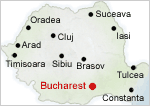BUCHAREST (BUCURESTI) [Boo koo reshte']
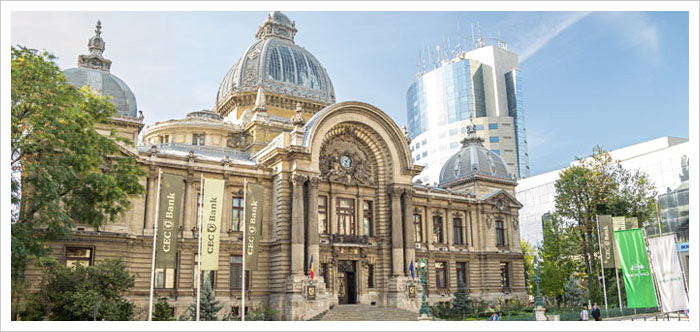
Bucharest General Information
Location: Southern Romania
Elevation: 190 - 295 ft (55 - 90 m)
Size: City of Bucharest - 88 sq.miles (228 sq.km);
Bucharest Metropolitan area - 587 sq.miles (1,521 sq.km)
Inhabited since: 500 BC
First documented: 1459 AD
Population: 1.921 milion
Known for its wide, tree-lined boulevards, glorious Belle Époque buildings and a reputation for the high life (which in the 1900s earned its nickname of "Little Paris"), Bucharest, Romania's largest city and capital, is today a bustling metropolis.
Romanian legend has it that the city of Bucharest was founded on the banks of the Dambovita River by a shepherd named Bucur, whose name literarily means "joy." His flute playing reportedly dazzled the people and his hearty wine from nearby vineyards endeared him to the local traders, who gave his name to the place.
House of the Free Press
(Casa Presei Libere)
Address: Piata Presei Libere 1 (map)
An impressive edifice standing in the northern part of the city, since 1956, Casa Scanteii (as it is still universally known)
was designed by architect Horia Maicu. The building is a smaller replica of the Lomonosov University in Moskow - Russia (inaugurated in 1953).
Between 1956 and 1989, the House of the Free Press housed almost all of Romania's capital printing presses and headquarters of print media companies.
Today, Casa Presei Libere carries out much the same function but the southern wing is now the home of the Bucharest Stock Exchange.
The Arch of Triumph
(Arcul de Triumf)
Address: Piata Arcul de Triumf (map)
Initially built of wood in 1878 to honor the Romanian soldiers who won the Independence War, Bucharest's Arch of Triumph was rebuit in 1922 and redecoreted in 1936 with base reliefs carved in granite brought from Deva (Transylvania).
Designed by the architect, Petre Antonescu, the Arch stands 89 feet high.
An interior staircase allows visitors to climb to the top for a panoramic view of the city.
The sculptures decorating the structure were created by leading Romanian artists, including Ion Jalea, Constantin Medrea and Constantin Baraschi.
...
Calea Victoriei
(Victory Way)
Calea Victoriei is Bucharest's oldest and arguably, most charming street.
Designed in 1692 to connect the Old Princely Court to Mogosoaia Palace, the street (initially named Podul Mogoșoaiei) was originally paved with oak beams.
The street became Calea Victoriei in 1878, after the Romanian War of Independence victory.
Between the two world wars, Calea Victoriei developed into one of the most fashionable streets in the city.
Stroll along this street from Piata Victoriei to Piata Natiunilor Unite to discover some of the most stunning buildings in the city, including the Cantacuzino Palace, the Revolution Square,
the Military Club,
National Savings Bank Palace and the National History Museum.
...
Cantacuzino Palace
(Palatul Cantacuzino)
Address: Calea Victoriei 141
Admission charge
Grigore Cantacuzino was thought to be one of Romania's wealthiest citizens in 1899. As Prime Minister, it was his wish to have the most elegant residence in Bucharest. Using the designs of architect Ion Berindei, the Cantacuzino Palace was built between 1898 and 1900 in eclectic French style. Combining a neoclassical architectural style with art nouveau elements, it features wrought iron balconies, tall arched windows and a porte-cochere (an elegant wrought-iron doorway) flanked by two lions.
Today, the palace houses the George Enescu Museum (more information).
...
Revolution Square
(Piata Revolutiei)
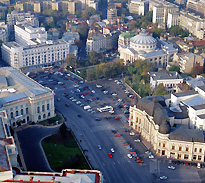 The square gained worldwide notoriety when TV stations around the globe broadcasted Nicolae Ceausescu's final moments in power on December 21, 1989. It was here, at the balcony of the former Communist Party Headquarters, that Ceausescu stared in disbelief as the people gathered in the square below turned on him. He fled the angry crowd in his white helicopter, only to be captured outside of the city a few hours later.
The square gained worldwide notoriety when TV stations around the globe broadcasted Nicolae Ceausescu's final moments in power on December 21, 1989. It was here, at the balcony of the former Communist Party Headquarters, that Ceausescu stared in disbelief as the people gathered in the square below turned on him. He fled the angry crowd in his white helicopter, only to be captured outside of the city a few hours later.
The square's importance stretches back long before the dramatic events of the 1989 Revolution. On the far side of the square stands the former Royal Palace, now home to the National Art Museum, the stunning Romanian Athenaeum and the historic Athenee Palace Hotel. At the south end of the square, you can visit the small, but beautiful, Kretzulescu Church.
...
The Royal Palace
(Palatul Regal)
Address: Calea Victoriei 49 - 53 (map)
Erected between 1927 and 1937 in neoclassical style, the palace was home to King Carol II and to his son, King Mihai I, until 1947, when the monarchy was abolished in Romania. It was inside the halls of this palace that King Mihai, aged 18, led a coup that displaced the pro-Nazi government during the World War II and put Romania on the Allies' side. Today, the former Royal palace houses the Romanian National Art Museum (more information).
...
The Romanian Athenaeum
(Atheneul Roman)
Address: Str. Benjamin Franklin 1 (map)
Tel: 021 315.00.26 or 315.25.67
www.fge.org.ro
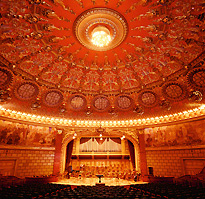 The work of French architect Albert Galleron, who also designed the National Bank of Romania, the Athenaeum was completed in 1888, financed almost entirely with money donated by the general public. One of the preeminent public fundraising campaigns ever in Romania, the "Give a penny for the Athenaeum" campaign saved the project after the original patrons ran out of funds. With its high dome and Doric columns, the Athenaeum resembles an ancient temple.
The work of French architect Albert Galleron, who also designed the National Bank of Romania, the Athenaeum was completed in 1888, financed almost entirely with money donated by the general public. One of the preeminent public fundraising campaigns ever in Romania, the "Give a penny for the Athenaeum" campaign saved the project after the original patrons ran out of funds. With its high dome and Doric columns, the Athenaeum resembles an ancient temple.
The lobby has a beautifully painted ceiling decorated in gold leaf, while curved balconies cascade in ringlets off a spiral staircase.A ring of pink marble columns is linked by flowing arches where elaborate brass lanterns hang like gems from a necklace. Inside the concert hall, voluptuous frescoes cover the ceiling and walls. Renowned worldwide for its outstanding acoustics, it is Bucharest's most prestigious concert hall and home of the Romanian George Enescu Philharmonic.
...
Kretzulescu Church
(Biserica Cretulescu)
Address: Calea Victoriei 47 (map)
Nestled amid the other historical buildings in Piata Revolutiei, this small red-brick Orthodox church was built in 1722 by the great chancellor Iordache Kretzulescu and his wife, Safta (a daughter of Constantin Brancoveanu) in the Brancovenesti architectural style. The interior frescoes were executed around 1860 by the famous Romanian painter Gheorghe Tattarescu.
...
Royal Palace Great Concert Hall
(Sala Palatului)
Located next to the Royal Palace, the concave-roof structure was built in 1960 to accommodate the 3,000 Communist party members who every five years attended the communist party congress. It was on this stage that Nicolae Ceausescu would deliver his vision of a multilaterally developed socialist society. Today, the massive auditorium plays host to various conferences and events, including some of the George Enescu International Festival concerts.
...
The Military Club
(Cercul Militar National)
Address: Blvd. Regina Elisabeta 21 (map)
Tel: 021 313.86.80
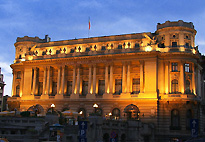 Standing guard imposingly, this neoclassical masterpiece, designed by Romanian architect Dimitrie Maimaroiu, was built in 1912 to serve the social, cultural and educational needs of the Romanian army. Banquets and official events are still hosted in the ballrooms, while the upstairs area is reserved for the army's library, as well as offices and classrooms for officer instruction. The main part of the building is off-limits to civilians, but the sumptuous restaurant and summer terrace is open to the public.
Standing guard imposingly, this neoclassical masterpiece, designed by Romanian architect Dimitrie Maimaroiu, was built in 1912 to serve the social, cultural and educational needs of the Romanian army. Banquets and official events are still hosted in the ballrooms, while the upstairs area is reserved for the army's library, as well as offices and classrooms for officer instruction. The main part of the building is off-limits to civilians, but the sumptuous restaurant and summer terrace is open to the public.
...
The Palace of the Savings Bank
(Casa de Economii si Consemnatiuni / CEC)
Address: Calea Victoriei 11 - 13 (map)
Boasting one of the most impressive neoclassical facades in the city, this structure was built in the 19th century to the design of French architect Paul Gottereanu (who between 1875 and 1900 designed more than 50 buildings in the city, to house the first Romanian Savings Bank. The square-shaped palace has a large central dome with metallic ribs separated by glass, which allows natural light to come in; there are also four smaller domes. The arch at the entrance, with its Corinthian columns, is a highlight of any architectural tour of the city.
...
Old Town Bucharest
(Centrul Vechi)
Lipscani Area
At the beginning of 1400s, most merchants and craftsmen - Romanian, Austrian, Greek, Armenian and Jewish - established their stores and shops in this section of the city; a jumble of streets between Calea Victoriei, Blvd. Bratianu, Blvd. Regina Elisabeta and the Dambovita River.
Soon, the area became known as Lipscani, named for the many German traders from Lipsca or Leiptzig.
Other streets took on the names of various old craft communities and guilds, such as Blanari (furriers), Covaci (blacksmiths), Gabroveni (knife makers) and Cavafii Vechii (shoe-makers). The mix of nationalities and cultures is reflected in the mishmash of architectural styles, from baroque to neoclassical to art nouveau.
Today, the area is home to art galleries, antique shops, coffeehouses, restaurants and night-clubs.
While walking in the narrow cobblestone streets one can imagine the long-gone shopkeepers outside near their stores, inviting bypassers to buy their merchandise.
...
Old Princely Court & Church
(Palatul si Biserica Curtea Veche)
Address: Strada Franceza 25 - 31 (map)
Tel: 021 314.03.75
Museum open: Mon. – Sun 10 a.m. – 5 p.m.;
Admission charge
At the centre of the historic area are the remains of the Old Princely Court (Curtea Veche), built in the 15th century by Vlad Tepes, also known as Vlad Dracula. According to local lore, Vlad kept his prisoners in dungeons which commenced beneath the Princely Court and extended under the city. All that remains today are a few walls, arches, tombstones and a Corinthian column.
The Old Court Museum was established in 1972 when an archaeological dig revealed the remains of the fortress, along with Dacian pottery and Roman coins, evidence of Bucharest's earliest inhabitants. The oldest document attesting to the city's origin under the name of Bucuresti (Bucharest) was discovered here. It was issued on September 20, 1459 and signed by Prince Vlad Tepes.
Next to the palace stands the Old Court Church (Biserica Curtea Veche), dating from 1559 and considered the oldest in Bucharest. For two centuries, the church served as coronation ground for Romanian princes. Some of the original 16th century frescoes have been preserved.
...
Manuc's Inn
(Hanul lui Manuc)
Address: Str. Franceza 62 - 64 (map)
Tel: 021 313.14.11
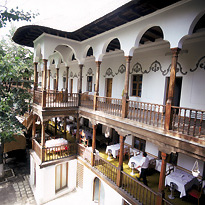 Built in 1804 by the wealthy Armenian trader Emanuel Marzaian (called by the Turks "Manuc Bey"),
the inn has the preliminary talks concerning the Peace Treaty that put an end to the Russian -Turkish War (1806-1812).
Built in 1804 by the wealthy Armenian trader Emanuel Marzaian (called by the Turks "Manuc Bey"),
the inn has the preliminary talks concerning the Peace Treaty that put an end to the Russian -Turkish War (1806-1812).
A favorite meeting place for tradesmen, Manuc's Inn has preserved to this day its character and flavor.
A restaurant, wine cellar and a pastry shop are now welcoming guests from all over the world.
...
The Beer Wagon Restaurant
(Carul cu Bere)
Address: Strada Stavropoleos 3 - 5 (map)
Tel: 021 313.75.60
The Beer Wagon restaurant and beer house became, soon after the opening in 1879, one of the most popular meeting places for Bucharest's literati who would gather to discuss matters of their time. Its neo-gothic architectural style is reflected both in the façades and the interior decorations: columns, arches, chandeliers, a wooden staircase, furniture and murals on the walls and ceiling.
...
National Bank of Romania
(Banca Nationala a Romaniei)
Address: Str. Lipscani 25 (map)
The National Bank of Romania (BNR) stands on the site of one of the most famous buildings in Romania: the Hanul Serban Voda, which from 1678 until 1883 was the home of various institutions ranging from a pub to an inn to a girl's dormitory! After two fires gutted the building, however, the land was leveled and in 1883, work began on the BNR, completed to the designs of French architects Cassien Bernard and Albert Galleron in 1885. Built in neoclassical French style, the building boasts a facade with Corinthian columns and an enormous central banking hall. The passing of time has left its marks on the building, but it remains a classic worthy of admiration.
...
University Square
(Piata Universitatii)
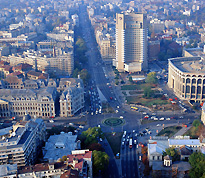 Buzzing with crowds and traffic from early morning until late at night, this area is one of the most popular meeting places in Bucharest. The square brings together some remarkable architectural masterpieces on each of its four corners, starting with the University of Bucharest's School of Architecture, the Bucharest National Theatre, the neoclassical Coltea Hospital and its lovely church (1702-1794) and the Sutu Palace, now home to the Bucharest History Museum.
Buzzing with crowds and traffic from early morning until late at night, this area is one of the most popular meeting places in Bucharest. The square brings together some remarkable architectural masterpieces on each of its four corners, starting with the University of Bucharest's School of Architecture, the Bucharest National Theatre, the neoclassical Coltea Hospital and its lovely church (1702-1794) and the Sutu Palace, now home to the Bucharest History Museum.
In the middle of the square, on a little island, 10 stone crosses pay respect to those killed during the 1989 revolution. Below the square is an underground passage with shops and eateries, allowing pedestrians to cross from one side of the square to another and to access the subway station.
...
University of Bucharest
(Universitatea Bucuresti)
Address: Blvd. Regina Elizabeta (near University Square)(map)
Bucharest remains first and foremost a hub of higher education. The University of Bucharest was founded in 1864 by Alexandru Ioan Cuza, ruler of the newly united principalities of Walachia and Moldova. Work on the neoclassical building began in 1857 and finished in 1859.
Between the two World Wars, the libraries and corridors of the University hosted an impressive number of Romanian personalities, including Mircea Eliade, Emil Cioran, Eugène Ionesco, Sergiu Celibidache.
Year-round, you can find book merchants near the University building selling anything from antique books, records, discontinued newspapers and illustrated broadsheets from another age to secondhand books.
...
Coltea Hospital
(Spitalul Coltea)
Address: Blvd. I.C. Bratianu 1 (map)
The oldest hospital in Bucharest, dating from 1704, Coltea was built on land belonging to the Vacaresti family, who at the time owned many of the great prosperities of the capital. The original building was destroyed by an earthquake in 1802, and the neoclassical building standing today dates from 1888.
The church next to the hospital is the original 1701 construction, and is currently undergoing much-needed renovation.
The hospital remains a functioning public health centre; you may enter only if you have official business.
The church, however, is open to all, and the saintly silhouettes on the ceiling are admirable.
...
Sutu Palace
(Palatul Sutu)
Address: Blvd. I. C. Bratianu 2 (near University Square) (map)
Famous for the grandiose balls held here in the 1900s, Sutu Palace was built in neogothic style between 1832 and 1834 by foreign minister Costache Sutu, to designs of architects Johann Veit and Konrad Schwinck. In 1862, the palace was redecorated by sculptor Karl Storck, who created three arcades and a monumental stairway; a huge Murano mirror was added in the hallway. Only the painted ceilings, the stucco, the parquet flooring and the tile stoves have been preserved.
Since 1959, the building has housed the Bucharest History & Art Museum (see details).
...
Communist legacy
Parliament Palace
(Palatul Parlamentului)
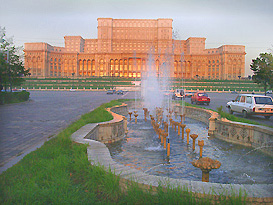 Address: Strada Izvor 2 - 4
Address: Strada Izvor 2 - 4
(map)
Tel: 021 311.36.11
Open to visitors: Mon. - Sun.
Bucharest Palace of Parliament Hours and Admission
(guided tours in English available)
Built at the special request of Nicolae Ceausescu, leader of Romania's Communist Party, the colossal Parliament Palace
- formerly known as "People's House" ( Casa Poporului ) -
is the world's second largest administrative building
after the U. S. Pentagon.
It took 20,000 workers and 700 architects to build this masive structure that boasts 12 stories, 1,100 rooms,
a 350-ft.-long lobby and eight underground levels, including an enormous nuclear bunker.
The Palace of Parliament it is the world's second-largest office building (floor area) and the third largest in volume (after Cape Canaveral Space Centre in the U.S. and the Great Pyramid in Egypt)
The crystal chandelier in the Human Rights Hall (Sala Drepturilor Omului) weighs 2.5 tons.
Some of the chandeliers have as many as 7,000 light bulbs.
When construction started on June 25, 1984, the building was intended it to be the headquarters of the country's Communist government.
Today, it houses Romania's Parliament, Bucharest International Conference Centre and Romnaia's Museum of Modern Art.
Built, furnished and decorated exclusively with materials sourced and made in Romania, the building reflects the work of the country's best artisans.
A guided tour takes visitors through a small section of dazzling rooms, huge halls and quarters used by the Senate (when not in session). The interior is a luxurious display of crystal chandeliers, mosaics, oak paneling, marble, gold leaf, stained-glass windows and floors covered in rich carpets.
Planing your visit:
Valid passport or national Identity Dard is required to gain access to the Palace of Parliament.
Large groups: reservations are strongly recommended.
Please E-mail a tour reservation request containing the following information:
- number of participants,
- exact date & approximate time of arrival,
- coach license plate,
- guide (English or French language)
- type of tour desired (standard, standard + terrace or standard + terrace + the underground).
Group tours need to be reconfirmed, on the day prior to the visit — please call 021 311.36.11
Palace of Parliament Visiting Rules and Regulations
Romania’s Parliament Palace, Bucharest
Facts and Figures:
- Location
1 mile southwest of Bucharest Old Town ( Centrul Vechi),
on the very place (called Dealul Arsenalului – Armory Hill) on which, in 1935,
king Carol II of Romania had planned to build Romania’s House of Representatives (Camera Deputatilor). - Public transportation
Nearest bus station: Pod Izvor (Bus # 104, 123, 124, 136, 385), 7 minutes walk
Nearest subway station: Izvor (M1), 5 minutes walk - Size:
Height: 282 ft. (89 metres)
Width: 788 ft. (240 metres)
Length: 886 ft. (270 metres)
Number of stories: 12 above ground and 8 underground
Built-up area: 3.8 million sq. ft. (359,000 sq.m.)
Foot print: 7,1 million sq. ft. (66.000 sq.m.)
Volume: 90 million cu. ft. (2.55 million cu. metres) - The Palace of the Romanian Parliament is the world's Heaviest Building!
- Quantities of construction materials used to build the Palace:
35.3 million ft³ (1,000,000 m³) of marble
31.8 million ft³ (900,000 m³) of different essences of wood
2.2 million ft³ (200,000 m³) of glass
4.4 billion lbs. (2 million tonnes) of sand
1.5 billion lbs. (700,000 metric tones) of steel and bronze
12.1 million lbs. (5,500 tonnes) of cement
2.2 million lbs. (1,000 de tonnes) of basalt stone
177 million ft³ (5,000,000 m³) of concrete - Materials used for finishes and decorations:
7.8 million lbs. (3,500 de tonnes) of crystal
2.4 million ft² (220.000 m²) of carpets
37,675 ft² (3,500 m²) of calf skin
2,800 chrystal chandeliers
1,409 ceiling light fixtures and mirrors - Other facts:
20.000 cars can be parked in the underground of the building,
The underground has two anti-atomic shelters with 5 ft. thick walls w radioactive radiation protection,
There are 1,100 rooms, 34 large function/ conference halls (fixed-seats or open-space),
four restaurants, three libraries, two underground parking and one concert hall.
With only three exceptions, all the materials used to build the palace have been produced or made in Romania.
The exceptions are:
-- small quantities of exotic wood that cannot be found in Romania,
-- the doors of Nicolae Balcescu Conference Hall, a gift received by Nicolae Ceausescu from Mobutu Sese Seko
at the time President of the Republic of Zaire / today Democratic Republic of Congo),
-- ventilation pumps with special filters, imported from Sweden.
The Civic Centre
(Centrul Civic)
Nicolae Ceausescu's building megalomania is perhaps best illustrated by with the construction of the Civic Centre,
an area located at the south end of the Palace of Parliament along Bulevardul Unirii.
The redevelopment of the area was supervised by Romania's Communist leader himself.
More than three square miles ( eight square km. or 2,000 acres) of buildings in the old section of the city
(including private residences, shops, two churches, a hospital and a noted Art Deco sports stadium) were leveled to make room for the construction of Stalinist apartment buildings topped with neoclassical follies.
Historic Churches
Saint Apostles' Church
(Biserica Sfintii Apostoli)
Address: Str. Sfintii Apostoli 1 (map)
Tel: 021 336.07.84
One of the oldest churches in Bucharest (with parts dating back to the 16th century and a steeple built in 1715), the Apostles' Church is brimming with some rather strange portraits that are well worth seeing.
Metropolitan Church
(Biserica Patriarhiei)
Address: Aleea Dealul Mitropoliei (map)
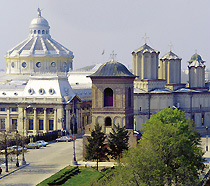 Set atop one of the city's few hills, known as Mitropoliei, the Metropolitan Church has been the centerpiece of the Romanian Orthodox faith since the 17th century. The church was built by Constantin Serban Basarab, ruler of the province of Walachia between 1656 and 1658, to a design inspired by the Curtea de Arges monastery. It became the Metropolitan Church in 1668 and the seat of the Romanian Orthodox Church in 1925.
Set atop one of the city's few hills, known as Mitropoliei, the Metropolitan Church has been the centerpiece of the Romanian Orthodox faith since the 17th century. The church was built by Constantin Serban Basarab, ruler of the province of Walachia between 1656 and 1658, to a design inspired by the Curtea de Arges monastery. It became the Metropolitan Church in 1668 and the seat of the Romanian Orthodox Church in 1925.
The Byzantine interior, containing the most dazzling of the city's iconostasis, as well as a couple of exquisitely carved side altars, bestows great beauty on the services presided over by the Romanian Patriarch. A huge crowd gathers here for the Easter midnight service.
The outstanding bell-tower at the entrance was built in 1698 and restored in 1958. Next to the church, and closed to the public, is the Patriarchal Palace (1708), residence of the Teoctist, supreme leader of the Romanian Orthodox Church.
Stavropoleos Church
(Biserica Stavropoleos)
Address: Str. Stavropoleos 4 (map)
Tel: 021 313.47.47
The Stavropoleos Church was built in 1724 by the Greek monk Ioanikie Stratonikeas. Featuring a combination of Romanian and Byzantine architecture, it has a beautiful façade and a delicately carved columned entrance. Surrounded by a peaceful garden, it is an architectural jewel, with beautiful frescoes and wood-painted icons. The mass (in Romanian) is worth viewing if you can find room in this small and cozy church.
St. Joseph's Cathedral
(Catedrala Sfantul Iosif)
Address: Str. G-ral Berthelot 19 (map)
Tel: 021 312.12.08
Constructed in red brick between 1873 and 1884, this Roman Catholic cathedral
is an architectural masterpiece combining both gothic and Roman elements.
Organ recitals are held every week.
St. Nicolas Church
(Biserica Sfantul Nicolae)
Address: Str. Ion Ghica 9 (map)
Tel: 021 314.64.50
Built in 1909 by the Russian Tsar Nicholas II for 600,000 gold rubles, this Orthodox Church has a wooden, gold-gilded iconostasis allegedly modeled after the altar in the Archangelskiy Cathedral in Moscow.
Jewish Bucharest
Bucharest is home to one of the oldest and most important Jewish communities in Romania. Sephardic Jews arrived here in the 16th century. Around the beginning of the 17th century, during the Cossack uprising, the first Ashkenazi Jews came from Ukraine and Poland. A sacred brotherhood, a charity box and a prayer house were registered in 1715.
Some of the synagogues built during the 18th and 19th century also featured ritual baths (mikve). By 1832, 10 holy houses had been established. Their number would increase significantly before the end of the century, almost every one having its own Rabbi and cult performers.
At the beginning of the 20th century, the Jewish population in Bucharest numbered 40,000 people with 70 temples and synagogues. From this great number, only a few survived the brutality of history - fascism and communism - and two still serve the city's present Jewish community.
Dr. Moses Rosen Museum of the History of the Jewish Community in Romania
(Muzeul de Istorie al Evreilor din Romania)
Address: Str. Mamulari 3
Tel: 021 311.08.70
Web: www.romanianjewish.org
Open: Mon. - Wed. & Fri. - Sun. 9:00am - 1:00pm; Thu. 9:00am - 4:00pm
Free Admission
Housed in the magnificently preserved Great Synagogue (1850) in the city's historically Jewish neighborhood, this museum traces the history of Romania's Jewish population. The displays include a collection of books written, published, illustrated or translated by Romanian Jews; a small collection of paintings of and by Romanian Jews (many of the same artists' works hang in the National Museum of Art) and memorabilia from Jewish theatres including the State Jewish Theatre.
The museum also contains a large collection of Jewish ritual objects from Romania, collected by Rabbi Moses Rosen (1912-1994), the late Chief Rabbi of the Romanian Jewry.
Choral Temple
(Templul Coral)
Address: Str. Sfanta Vineri 9 (map)
Tel: 021 312.21.96
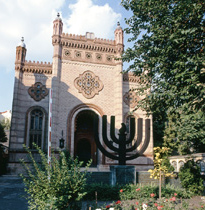 Built in 1857, the red brick temple (noted for its magnificent Moorish turrets, choir loft and organ) is the largest active synagogue in Bucharest.
Built in 1857, the red brick temple (noted for its magnificent Moorish turrets, choir loft and organ) is the largest active synagogue in Bucharest.
Services are held every day at 8am and 7pm.
On Saturday, they are held at 8:30am and 7pm.
Yeshoah Tova Synagogue
Address: Str. Tache Ionescu 9 (map)
In a busy side street going towards Piata Amzei from Magheru Bulevard stands the only other functioning synagogue in the city apart from the Choral Temple. Services take place at Sabbath hour on Friday and Saturday evenings.
Bucharest Jewish Community
(Comunitatea Evreilor din Bucuresti)
Address: Str. Sf. Vineri 9 -11
Tel: 021 313.17.82
Bucharest Museums
Art Collections Museum
(Muzeul Colectiilor de Arta)
Address: Calea Victoriei 111
Tel: 021 212.96.41
www.mnar.arts.ro
Admission charge
Founded in 1978, the Art Collections Museum, a branch of the National Art Museum, houses private collections donated over the course of time. Collections include European as well as Oriental art works.
Bucharest History & Art Museum
(Muzeul Municipiului Bucuresti)
Address: Blvd. I.C.Bratianu 2
Tel: 021 315.68.58
www.muzeulbucurestiului.ro
Open: Wed. - Sun. 10 a.m. - 6 p.m.; Closed Mon. & Tue.
Admission charge
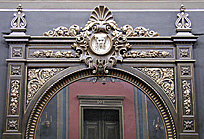
Housed in the neoclassical Sutu Palace(1834), the museum features some 300,000 artifacts, from coins, books, maps, engravings, paintings, arms and furniture to old traditional costumes. Among the most valuable exhibits are the document attesting for the first time the name of the city of Bucharest, issued by Vlad Tepes in 1459, and a sword set in precious stones that belonged to Prince Constantin Brancoveanu (1688-1714).
Communist Iconography Museum
Address: Sos. Kiseleff 3 (inside the Romanian Peasant Museum)
A small, but fascinating, room is home to an interesting collection of communist-era bust sculptures (including that of Lenin), paintings and memorabilia.
Cotroceni Palace & Museum
(Muzeul National Cotroceni)
Address: Str. Geniului 1
Tel: 021 317.31.07 or 430.44.85
www.muzeulcotroceni.ro
Open: Tue. - Sun. 9 am - 5 pm; Closed Mon.
Admission charge (Guided tours are available in English)
Note: Visits by appointment only; please call for reservations.
A former royal residence built between 1679 and 1681 by Prince and ruler Serban Cantacuzino, the palace was home to King Carol I, who made important changes in its architecture. At the end of the 19th century, Heir-to-the-Crown Ferdinand ordered the partial demolition of the palace, which was later reconstructed by French architect Paul Gottereau in neoclassical style. In 1977, Nicolae Ceausescu transformed it into an official guesthouse with the addition of a new wing.
After 1990, the old wing of the palace became a museum. The Oriental Hall, the Norwegian Hall and the Queen's Chamber are almost unchanged from the original design and are worth visiting. Very important collection of medieval art also can be seen here. The new wing serves as the seat of the Romanian Presidency.
George Enescu Museum
(Muzeul National George Enescu)
Address: Calea Victoriei 141
Tel: 021 318.14.50
www.GeorgeEnescu.ro
Open: Tue. - Sun. 10:00am - 5:00pm; Closed Mon.
Admission charge
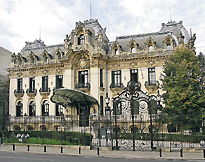 The museum, housed in the Cantacuzino Palace, displays documents and various objects that belonged to the great Romanian composer and violinist George Enescu (1881-1955), including a Bach music collection he received as a gift from Queen Elisabeta of Romania. A world-class violinist, Enescu studied at the Vienna Conservatory, where he met German composer Johannes Brahms and where he also gave his first concerts. In Paris, Enescu graduated from the French Conservatory in 1899. His best-known works, the Romanian Rhapsodies, earned him national and international fame. In 1936, his Oedipe tragic opera premiered in Paris and Enescu was awarded the French Legion of Honor award for the composition. A member of the Romanian Academy and corresponding member of the Institute of France, George Enescu was the teacher of renowned violinist Yehudi Menuhin. Every two years, the Romanian Athenaeum celebrates the maestro by hosting the George Enescu International Festival.
The museum, housed in the Cantacuzino Palace, displays documents and various objects that belonged to the great Romanian composer and violinist George Enescu (1881-1955), including a Bach music collection he received as a gift from Queen Elisabeta of Romania. A world-class violinist, Enescu studied at the Vienna Conservatory, where he met German composer Johannes Brahms and where he also gave his first concerts. In Paris, Enescu graduated from the French Conservatory in 1899. His best-known works, the Romanian Rhapsodies, earned him national and international fame. In 1936, his Oedipe tragic opera premiered in Paris and Enescu was awarded the French Legion of Honor award for the composition. A member of the Romanian Academy and corresponding member of the Institute of France, George Enescu was the teacher of renowned violinist Yehudi Menuhin. Every two years, the Romanian Athenaeum celebrates the maestro by hosting the George Enescu International Festival.
Grigore Antipa Natural History Museum
(Muzeul National de Istorie Naturala)
Address: Sos. Kiseleff 1
Tel: 021 312.88.63
www.antipa.ro
Open: Tue - Sun 1 am - 8 pm (last admission 7 pm). Closed on Mondays.
Admission charge
Recently renovated, this museum is the largest natural history museum in Romania, housing collections of reptiles, fish, birds and mammals. More than 300,000 artifacts and specimens are on display, including a dinosaur fossil. A whole floor is dedicated to sea life and features examples of whales, dolphins and seals. The museum also contains a beautiful butterfly collection.
Minovici Museum of Ancient Western Art
(Muzeul de Arta Veche Apuseana)
Address: Str. Dr. Minovici 3
Tel: 021 665.73.34
www.MuzeulBucurestiului.ro
Admission charge
In addition to the small renaissance art collection of Dumitru Minovici, who made barrels of lei in the oil business in the 1930s, the museum features Belgian tapestries, Dutch furniture, Swiss stained glass, a complete library and Italian paintings from the 16th and 17th centuries.
Museum of the Romanian Peasant
(Muzeul Taranului Roman)
Address: Soseaua Kiseleff 3
Tel: 021 317.96.60
www.MuzeulTaranuluiRoman.ro
Open: Tue. - Sun. 10 am - 6 pm; Closed Mon.
Admission charge
Opened in 1906, the museum features the richest folk art collection in Romania, with over 90,000 artifacts that trace the colorful and diverse cultural life of the Romanian people. The Pottery Collection includes some 18,000 items, representative of the most important pottery centres in the country. The oldest ceramic item found in the museum bears the inscription 1746. Equally impressive, the Costume Collection comprises almost 20,000 traditional folk costumes, some dating from the beginning of the 19th century, giving visitors insight into the styles and traditions of the Romanian peasants.
The displays dip into all aspects of life in the Romanian countryside. Exhibits of agricultural tools, carpets, icons, furniture, photographs and films build up a complete picture of Romanian folk culture. In one of the galleries, you can see a wooden church and in another, a wooden peasant house. Four more wooden churches stand in the outdoor museum area. In 1996, the museum was named European Museum of the Year. Visitors can buy regional handcrafts and textiles in the museum's extensive gift shop.
National Art Museum
(Muzeul National de Arta)
Address: Calea Victoriei 49-53
Tel: 021 313.30.30
www.mnar.arts.ro
Open: Wed. – Sun.. 11 a.m. - 7 p.m. (May - September);
Wed. - Sun. 10 a.m. – 6 p.m. (October - April); Closed Mon. & Tue.
Admission charge (English guided available)
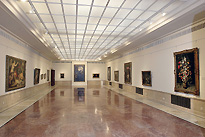 Romania's leading art museum was founded in 1948 to house the former Royal Collection, which included Romanian and European art dating from the 15th to the 20th century. Located in the neoclassical former Royal Palace, set amid a wealth of historic buildings such as the Romanian Athenaeum, Kretzulescu Church and the Hotel Athenee Palace-Hilton, the museum currently exhibits over 100,000 works divided into two major sections. Its National Gallery features the works of major Romanian artists, including Grigorescu, Aman and Andreescu. There is also a roomful of early Brancusi sculpture, such as you won't find anywhere else, demonstrating how he left his master, Rodin, behind in a more advanced form of expression. The European Gallery, comprising some 15 rooms, displays little-known art gems from the likes of El Greco, Monet, Rembrandt, Renoir, Breughels (father and son) Cezanne and Rubens. If you only have time to visit one gallery, make it the Romanian one. It is the most complete collection of Romanian works of art in the country and quite possibly, the world.
Romania's leading art museum was founded in 1948 to house the former Royal Collection, which included Romanian and European art dating from the 15th to the 20th century. Located in the neoclassical former Royal Palace, set amid a wealth of historic buildings such as the Romanian Athenaeum, Kretzulescu Church and the Hotel Athenee Palace-Hilton, the museum currently exhibits over 100,000 works divided into two major sections. Its National Gallery features the works of major Romanian artists, including Grigorescu, Aman and Andreescu. There is also a roomful of early Brancusi sculpture, such as you won't find anywhere else, demonstrating how he left his master, Rodin, behind in a more advanced form of expression. The European Gallery, comprising some 15 rooms, displays little-known art gems from the likes of El Greco, Monet, Rembrandt, Renoir, Breughels (father and son) Cezanne and Rubens. If you only have time to visit one gallery, make it the Romanian one. It is the most complete collection of Romanian works of art in the country and quite possibly, the world.
National Geological Museum
(Muzeul National de Geologie)
Address: Sos. Kiseleff 2
Tel: 021 212.89.52
www.Geology.ro
Open: Mon. - Sun. 10 am - 4 pm
Admission charge
Impressive collections of minerals and quartz formations specific to the area are found here,
including a well-presented geological structure of Romania's territory.
National History Museum
(Muzeul National de Istorie al Romaniei)
Address: Calea Victoriei 12
Tel: 021 315.82.07
www.mnir.ro
Open: Wed. - Sun. 10 am - 6 pm;
Closed Mon. and Tue
Admission charge
Housed in a 1900s neoclassical building that once served as the city's main post office, the museum offers a great introduction to the exciting history of Romania. Spread throughout 41 rooms, the exhibits recount the country's development from prehistoric times to the 20th century. The highlight is the National Treasury Hall where visitors can enjoy a dazzling display of some 3,000 gold items, including jewelry and valuable Neolithic artifacts.
Among the displays are the 12 pieces of the 4th century Pietroasele Treasure Collection. First presented at the 1867 World's Fair in Paris, it was considered the most valuable treasure collection in the world (the tomb of Tutankamon had not yet been discovered). One year later, the collection was displayed at the Second Annual International Exhibition in London and in 1872, at the International Exhibition in Vienna.
National Military Museum
(Muzeul Militar National)
Address: Str. Mircea Vulcanescu 125-127
Tel: 021 638.76.30
www.MuzeulMilitar
Open: Tue. - Sun. 9 am - 5 pm; Closed Mon.
Admission charge
Founded in 1972, the museum illustrates the most important battles for independence and freedom in Romanian history. The museum features collections of Oriental and Occidental weapons, Romanian and foreign uniforms, military medals and awards, trophies, artillery, canons and airplanes as well as a library of historical military documents.
The centerpiece is the 1989 Revolution exhibit, displaying mainly personal belongings donated by families of soldiers and civilians killed during the upheaval.
National Museum of Contemporary Art
(Muzeul National de Arta Contemporana)
Address: Calea 13 Septembrie 1, entrance E4
Tel: 021 411.10.40
www.mnac.ro
Open: Wed. - Sun. 10 am - 6 pm; Closed Mon. & Tue.
Admission charge
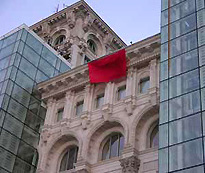 Bucharest's newest museum, the MNAC, as it is often called by museum-goers, displays works of Romania's contemporary artists as well as many temporary exhibits by international artists. The museum is housed in a wing of the Palace of Parliament, the space which would have served as Nicolae and Ileana Ceausescu's private apartment (where just the bathroom occupied 680 square feet, while the adjoining boudoir was three times that size).
Bucharest's newest museum, the MNAC, as it is often called by museum-goers, displays works of Romania's contemporary artists as well as many temporary exhibits by international artists. The museum is housed in a wing of the Palace of Parliament, the space which would have served as Nicolae and Ileana Ceausescu's private apartment (where just the bathroom occupied 680 square feet, while the adjoining boudoir was three times that size).
National Museum of Old Maps & Books
(Muzeul National al Hartilor si Cartii Vechi)
Address: Str. Londra 39
Tel: 021 230.44.68
www.MuzeulHartilor.ro
Open: Wed. - Sun. 10 am - 6 pm; Closed Mon. & Tue.
Admission charge
This museum is worth a visit, especially if you are interested in old maps and books.
Residence of Romania’s former Communist leader Nicolae Ceausescu (The Spring Mansion)
(Muzeul Palatul Primaverii)
Address: Bulevardul Primaverii 50
Telephone: 021 318.09.89
www.CasaCeausescu.ro
Open: Tue. - Sun.: 10 am - 5 pm
Closed Mon.
Admission charge, Reservations are recommended
For a quarter of a century (1965 - 1989) the “Spring Mansion” served as the private residence of Nicolae and Elena Ceauşescu and their three children, Nicu, Zoia, and Valentin.
A variety of woods, both native (oak, sycamore, cherry, walnut) and exotic (mahogany, rosewood, African pear, Canadian cherry), have been used for building and decorations.
The residence is home to an impressive collection of paintings ( by Octav Băncilă, Camil Ressu, Rudolf Cumpăna, Dumitru Ghiață, George Baron Lowendal ), handmade tapestries and mosaics designed by Romanian artists Olga Porumbaru and Florin Pârvulescu.
Romanian Railways Museum - Bucharest
(Muzeul Cailor Ferate Romane)
Address: Calea Grivitei 193 B
Tel: 021 222.75.20
Access: Nord Train Terminal (Gara de Nord), track # 14.
Website
Open: Wed. - Sun. 10 am - 6 pm;
Admission charge
The Railways Museum exibits include one of the largest train diorama in Europe, an 1869 Morse telegraph,
railways memorabilia including pictures and Romanian Railways uniforms.
Several passenger train wagons and engines are on display in the open-air section of the museum.
"Storck" Art Museum
(Muzeul de Arta Frederic Storck si Cecilia Cutescu-Storck)
Address: Str. Vasile Alecsandri 16
Telephone: 021 317 38 89
www.MuzeulBucurestiului.ro
Open: Tue. - Sun. 9 am - 4 pm; Closed Mon.
Admission charge
This museum pays tribute to the works of sculptor Frederick Storck, founder of the Romanian school of architecture, and his wife, Cecelia Cutescu-Storck, an artist and a keen advocate of enhanced recognition for women in the arts. Some 150 paintings and 250 sculptures are featured in the beautiful Storck residence,
built in 1913 by a French architect after the plans of Frederick Storck.
Technology Museum
(Muzeul Tehnic)
Address: Str. Candiano Popescu 2 (Carol Park)
Tel: 021 336.93.90
www.mnt-leonida.ro
Open: Wed. - Sun. 11 am - 6:30 pm;
Closed Mon. & Tue.
Admission charge
This museum displays some 5,000 items covering a wide range of industrial models:
turbines, compressors,
steam engines, the cylinder from the first steam engine that was used in a Romanian factory,
as well as antique cars and motorcycles.
Painter Theodor Pallady Museum
(Muzeul Theodor Pallady)
Address: Str. Spatarului 22
Tel: 021 211.49.79
www.MNAR.Arts.ro
Open:
Wed. – Sun.. 11 a.m. - 7 p.m. (May - September);
Wed. - Sun. 10 a.m. – 6 p.m (October - April);
Closed Mon. & Tue.
Admission charge
Housed in the beautifully restored Melik house, built around 1750
by the rich Armenian businessman Hagi Kevork Nazaretoglu,
the museum features paintings and sketches by Romanian artist Theodor Pallady
as well as numerous other art objects.
Village Museum
(Muzeul Satului)
Address: Soseaua Kiseleff 28 - 30
Tel: 021 317.91.03
www.Muzeul-Satului.ro
Open: Mon. 9 a.m. – 5 p.m.;
Tue. - Sun. 9 a.m. - 7 p.m.
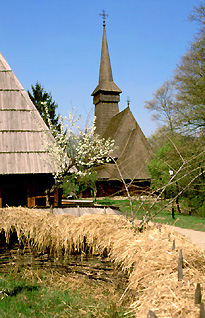 Founded by royal decree in 1936, this fascinating outdoor museum, the largest in Europe, covers some 30 acres on the shores of Lake Herastrau in Herestrau Park. It features a collection of 50 buildings representing the history and design of Romania's rural architecture. Steep-roofed peasant homes, thatched barns, log cabins, churches and watermills from all regions of the country were carefully taken apart, shipped to the museum and rebuilt in order to recreate the village setting. Throughout the year, the Village Museum hosts special events where you will have a chance to witness folk artisans demonstrating traditional skills in weaving, pottery and other crafts. Folk arts and crafts are available at the museum gift shop.
Founded by royal decree in 1936, this fascinating outdoor museum, the largest in Europe, covers some 30 acres on the shores of Lake Herastrau in Herestrau Park. It features a collection of 50 buildings representing the history and design of Romania's rural architecture. Steep-roofed peasant homes, thatched barns, log cabins, churches and watermills from all regions of the country were carefully taken apart, shipped to the museum and rebuilt in order to recreate the village setting. Throughout the year, the Village Museum hosts special events where you will have a chance to witness folk artisans demonstrating traditional skills in weaving, pottery and other crafts. Folk arts and crafts are available at the museum gift shop.
Zambaccian Museum
(Muzeul Zambaccian)
Address: Str. Zambaccian 21A
Telephone: 021 230.19.20
www.mnar.arts.ro
Open: Wed. - Sun.: 11 am - 7 pm; (May - September);
Wed. - Sun.: 10 am - 6 pm (October - April);
Closed Mon. & Tue.
Admission charge
The museum exhibits the private art collection of art critic and collector Krikor Zambaccian (1889-1962).
Works of Romanian painters: Ion Andreescu, Nicolae Grigorescu, Stefan Luchian, Theodor Pallady and Nicolae Tonitza,
who have been inspired by the Impressionists, can be admired at the Zambacian Museum.
Although Zambaccian was a big patron of the art of his home country,
during his studies in Belgium and France (1907 - 1913)
he purchased numerous European works from artists such as Cezanne, Renoir, Delacroix, Corot, Derain, Matisse, Pissaro, Bonnard, Utrillo and Picasso.
The museum preserves the initial display as it was conceived by the art collector himself.
There are also several beautiful small sculptures that complement the canvases.
Museum of Senses
(Muzeul Simturilor)
Address: Cotroceni AFI Shopping Mall
Bulevardul Vasile Milea 4
www.MuseumOfSenses.ro
Telephone: 0757 070.073
Open: daily 10 am - 10 pm
Romania’s equivalent of Ripley's Believe It or Not is a place for fun and entertainment and a bad weather ‘refuge’ for locals and visitors.
Parks & Gardens
Cismigiu Garden
(Gradina Cismigiu)
Address: Blvd. Regina Elisabeta (across from Bucharest City Hall)
Designed in 1845 by the German landscape architect Carl Meyer, the garden opened to the public in 1860. The name, Cismigiu, comes from the Turkish cismea, meaning "public fountain." More than 30,000 trees and plants were brought from the Romanian mountains, while exotic plants were imported from the botanical gardens in Vienna. Cismigiu is Bucharest's oldest park and a great place to stroll and enjoy a break from the hectic city. Set amid green lush lawns and winding paths, the park offers a lake with rowboat rentals, a beer garden, a playground for children, a chess area for amateurs and plenty of park benches for relaxing and people-watching.
Botanical Garden
(Gradina Botanica)
Address: Sos. Cotroceni 32 (across from Cotroceni Palace)
Tel: 021 410.91.39
Open: Mon. - Sun. 8:00am - 5:00pm
Website
Admission charge
Opened in 1891, the garden features over 5,000 varieties of plants from Romania and around the world.
The garden is also home to the Botanical Garden Museum, housed in a beautiful "Brancovenesc-Style" building.
Here, you can peruse manuscripts, old botanical research devices and a collection of artifacts made of vegetal materials. Locals treat the gardens as a park, and on warm afternoons, you may see more young lovers than plants.
The huge greenhouses are open Tue, Thu, Sat, Sun, 9am - 1pm.
Carol I Park
(Parcul Carol I)
Address: Calea Serban Vodá
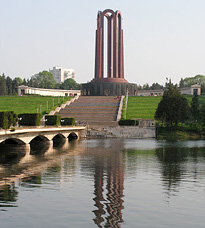 This large park is one of the most beautiful in the city and contains a massive monument that once housed the remains of communist leader Gheorge Gheorgiu Dej, as well as the eternal flame that marks the grave of the Unknown Soldier.
This large park is one of the most beautiful in the city and contains a massive monument that once housed the remains of communist leader Gheorge Gheorgiu Dej, as well as the eternal flame that marks the grave of the Unknown Soldier.
Designed by French landscape architect Eduard Redont in 1900s, the park offers pleasant walks down tree-lined paths, a good view of central Bucharest (from the monument) and plenty of photo opportunities. In summertime, the park's Arenele Romane is the stage for open-air concerts.
Herastrau Park
(Parcul Herastrau)
Address: Sos. Kiseleff 32
Spread over some 400 acres, from the Arch of Triumph to the Baneasa Bridge,
the park is home to numerous attractions, including a boat rental complex, tennis courts, and a rather old-fashioned fairground. In the summertime,
many terraces open up on the shores of the lake.
For an overview of the park, take a ride around the lake on the ferry or rent your own boat. The park is also home to the Village Museum.
The area surrounding the park holds even greater treasures.
The streets between Bulevardul Mircea Eliade and Soseaua Kisileff contain extraordinarily beautiful houses in architectural styles ranging from 19th century neoclassical to 20th century art nouveau and modern luxury villas.
This is where Bucharest's elite once lived - and still do today.
Bucharest - Hop On/ Off Sightseeing Bus Tours
Hop-on, hop-off bus tours are operated daily - during the warm season (May through October) - on a fleet of double-decker buses.
Travelers can get an introduction to Bucharest's fascinating architectural mix
and get familiar with the city's central neighborhoods and places of interest, in less than one hour.
Fast Facts
Current status: Available.
2021 (Tentative) Dates of operation: June 1 - October 31 (weather permitting)
Bucharest hop on/ off tours will be suspended during the cold weather months
(late-fall until late-spring).
Hours of operation: 10 a.m. - 9:45 p.m.
Last departure from Piata Presei Libere to Piata Unirii at 9:00 p.m.,
Last departure from Piata Unirii to Piata Presei Libere at 9:25 p.m.
Frequency: every 20 minutes
Total length of the route: 9.5 miles
Number of stops: 14 (see/print map)
24-Hour Ticket (card):
Adults: 25 lei (about $6.25)
Children (up to 7 years old): free
Youth (7 to 14 years old): 10 lei (about $2.75)
Note: Tickets can be purchased on board or at most hotels
and are valid for 24 hours from the time of validation.
Sights and major attractions include:
Village Museum (Muzeul Satului), Arch of Triumph (Arcul de Triumf), Natural History Museum (Muzeul Antipa),
Geology Museum (Muzeul de Geologie), Museum of the Romanian Peasant (Muzeul Taranului Roman),
Headquarters of the Romanian Government (Palatul Victoria), The Romanian Athenaeum (Ateneul Roman),
National Museum of Art (Muzeul National de Arta), Church Cretulescu (Biserica Cretulescu),
The Savings Bank (Palatul CEC), National History Museum (Muzeul National de Istorie),
Parliament's Palace (Palatul Parlamentului), Romanian Patriarchy (Patriarhia Romana), Manuc's Inn (Hanul lui Manuc), Bucharest University (Universitatea), Museum of the City of Bucharest (Muzeul Municipiului Bucuresti),
National Theatre (Teatrul National), Academy of Economic Studies (Academia de Studii Economice)
Bike Tours: Discover "Red Bucharest" with 'green' transportation ...
Ride a bicycle through some of Bucharest's parks and learn about the city's Communist architecture,
including the massive Palace of Parliament and the House of the Free Press.
Your local guide will also take you to back streets and will offer information about little-known areas of the city.
When: every day at 3 pm, reservations are mandatory
Tour starts: Charles de Gaulle Circus, at the entrance to Herastrau Park,
next to General Charles de Gaulle statue.
Staff wears a distinctive green outfit.
Map
Tour ends: at Parcul Tineretului (Youth's Park)
Duration: three hours and 30 minutes(including one snack break).
Price: from 115 Lei ($29.00) / participant
(includes: Bike, guide, snack and bottle of water).
More information
Walking Tours
Free walking tour of Bucharest with a local guide
 Discover Romania's capital city landmarks
Discover Romania's capital city landmarks
(including Palace of Parliament, Stavropoleos Church, Manuc's Inn, the Old Town, Bucharest University),
and the city's fascinating mix of architectural styles.
When:
April - September: every day at 10:30 a.m. and 6 p.m.
October - March: every day at 10 a.m. and 3 p.m.
Tour starts: from Parcul Unirii (Union Plaza Park).
Tour ends: at Piata Universitatii (University Circus)
Duration: two hours.
Cost: FREE
No reservation is necessary.
If you liked the tour you can tip your tour guide.
More info: www.Bucharest.WalkaboutFreeTours.com
Bucharest Independent City Walks
This section is courtesy of Ms. Rosemary K. Rennon
The following walks are designed to guide you around the four main areas of Bucharest,
pointing out several unique sights.
Stray from the routes as you wish, as you're sure to find other interesting places along the way that are not mentioned here.
Allow approximately three hours for each walk.
Walk # 1 North of Center
This beautiful walk takes you through the quiet area n orth of the city center. Begin at Piata Victoriei with the government's Victoria Palace (Palatul Victoria) on its east side. Cross the square and walk north along tree-lined Soseaua Kiseleff. On your left are the Grigore Antipa Natural History Museum and the Museum of the Romanian Peasant; a little farther up on the right is the National Geological Museum.
After passing through Kiseleff Park, stroll northward along the grand old mansions that line the shaded avenue all the way up to the Arch of Triumph (Arcul de Triumf). There begins Herestrau Park with its lake, gardens and outdoor restaurants. You will also pass the entrance to the wonderful open-air Muzeul Satului (Village Museum); take time to stop in and admire the numerous traditional rural architectural styles.
Ending at the north end of the park, off Piata Presei Libere you'll find the RomExpo exhibit center and the World Trade Center Plaza at Pullman (former Sofitel) Hotel. There's a fancy shopping arcade inside and a very nice coffee shop in the hotel where you can get a bite to eat. Catch bus # 335 back to Piata Charles de Gaulle for the Aviatorilor subway station (Metrou) or bus #331 to Piata Romana.
Walk # 2 West – Central
This walk follows the route of Bucharest's most famous historic avenue, Calea Victoriei, Beginning at Piata Victoriei, walk south along Calea Victoriei passing Casa Vernescu, the George Enescu Museum, housed in the beautiful Cantacuzino Palace, and the Art Collections Museum.
Two blocks south of Bulevardul Dacia, detour left onto Strada Piata Amzei where you'll come upon the colorful open-air produce market (Piata Amzei). Return to Calea Victoriei and turn left to resume the walk south, stopping in the shops along the way.
Upon reaching Piata Revolutiei you will find the Athenee Palace Hilton hotel, the Romanian Athenaeum (Atheneul Roman) concert house (ask for an inside tour), the National Art Museum, housed in the former Royal Palace, the beautiful University Library, the former Communist Party Central Committee building, and finally, the Kretulescu Church built in 1725.
Continuing south on Calea Victoriei, you'll pass more shops and hotels; note the Odeon Theater, sitting back from the street on the left. On the right you'll come to The Military Club which has an outdoor café and an art gallery.
Turn west (right) at the corner onto Bulevardul Regina Elisabeta and follow it to Cismigiu Garden, the last stop on this walk. Stroll around the lake or just relax watching the rowboats. The boathouse café offers snacks and refreshments.
Walk # 3 East – Central
This walk takes you along Bucharest's busiest commercial and shopping area. The boulevard changes names five times, but here you will cover the length of only three of its five sections: General Magheru, Nicolae Balcescu and I.C. Bratianu.
Starting from Piata Romana, you might first walk east on Bulevardul Dacia for a look at some of the embassy mansions; then return to Piata Romana.
Next, head south on Bulevardul General Magheru. The street is filled with clothing stores, sidewalk vendors, pastry shops, cinemas, stationary stores (papeterie), and crystal shops.
On the east side of the Bulevardul Balcescu section you will find the Libraria Noi bookstore which has a good selection of American picture books and English novels. There are several art galleries along here, including two in the National Theater which is next to the high-rise Intercontinental Hotel. Behind the hotel are the American Consulate and the American Library. Reaching Piata Universitatii, on the west side of the street you will see Bucharest University and the sidewalk book and flower vendors; sit a moment at the fountain in the adjoining plaza and watch the activity. The underground subway (Metrou) concourse has shops, newsstands with American magazines, and several fast food eateries, including a pastry shop and pizzeria.
This underground passage is the easiest place to cross the boulevards, rather than deal with street traffic.
South of Piata Universitatii the street name changes to Bulevardul I.C. Bratianu. On your right is the Bucharest History & Art Museum, housed in the neoclassical Sutu Palace, built in 1835.
Farther down, across the boulevard will be Sfantul Gheorghe cel Nou Church, built in 1701. The eastern end of Strada Lipscani meets the boulevard on the west side.
Continuing south, you will end this walk at Piata Unirii where you will find department stores, a large grassy square with park benches to rest on and its enormous complex of fountains. Piata Unirii's two subway (Metrou) lines link with all other subway stops.
Walk # 4 South
This route weaves through a tangle of colorful side streets in Bucharest's old historic district. Be extra alert here, as you will do some backtracking. Begin at the crossroads of Calea Victoriei and Bulevardul Regina Elisabeta. Walk south on Calea Victoriei, along the east side of the street. Duck into Pasajul Villa Cross (also called Pasajul Bijuteria), a golden skylit arcade of boutiques. Follow its U-shape back to Calea Victoriei and walk south a block, to the beginning of Strada Lipscani.
Stroll Strada Lipscani to see the vendors and shops, then return to Calea Victoriei.
Heading south again on Calea Victoriei, next turn left onto Strada Stavropoleos to arrive at Caru cu Bere restaurant. If you can't stop in for a beer or snack, at least peek inside to see its magnificent interior. Farther down the street is the tiny Biserica Stavropoleos (church), built in 1724. Here you can either cut south via Strada Postei to Strada Iuliu Maniu, or return to Calea Victoriei and go south, past the National History Museum to reach Strada Iuliu Maniu. Following Strada Iuliu Maniu east, you will come to the remains of the Curtea Veche (Old Princely Court) of the real Prince Dracula and his Princely Church, the oldest in Bucharest.
Just across the road is the former caravansary Hanul lui Manuc, now a restaurant and inn. Go inside the courtyard for a look at its timbered design, or stop there for some food and drink.
From this point, take the narrow side street south to exit the neighborhood at the Dambovita River.
Across the river you will see the 120-year-old Palace of Justice. Cross the boulevard to reach the broad, green Piata Unirii. Here you can rest while watching the fountains and the people.
From the south end you can see Nicolae Ceausescu's huge "House of the People", now Parliament Palace. When rested, head west along Bulevardul Unirii toward the Parliament Palace; this area is the Civic Center. When you reach the building, turn right, and walk north, back to the river.
Cross the Dambovita again at the Izvor Bridge. Walk in a block to Bulevardul Regina Elizabeta, then turn right and you'll wind up across the street from Cismigiu Garden.
To end this walk continue east on Bulevardul Elisabeta to Calea Victoriei; or go a little farther toward Piata Universitatii and its subway (Metrou) station.
Nearby Attractions
Mogosoaia Palace & Brancovenesc Museum
(Palatul Mogosoaia & Muzeul Brancovenesc)
Where: 9 miles NW of Bucharest
Address: Str. Valea Parcului 1
Access:
Public transportation
From Bucharest train terminal: subway M4 to Parc Bazilescu then metro-area bus 460 to Mogosoaia,
From downtown Bucharest: bus # 331 to Damaroaia then metro-area bus 460 to Mogosoaia,
car, taxi
Tel: 0786 705.985
www.PalatulMogosoaia.ro
Open:
Tue. - Sun.: 10 am - 6 pm (May 1 - October 31)
Tue. - Sun.: 9 am - 5 pm (November 1 - April 30)
Admission charge
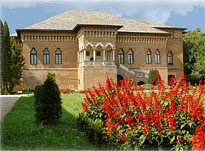 Located in the village of the same name on the shore of Mogosoaia Lake, this palace reflects the Brancovenesc architectural style, featuring traditional Romanian staircase balconies, arcades and columns. Built by the Walachian prince Constantin Brancoveanu between 1698 and 1702 as a summer residence, the palace features a beautiful Venetian-style loggia on the facade facing the lake and a balcony with intricate Brancovenesc-style carvings overlooking the main courtyard. Today, the palace houses the Brancovenesc Museum with exhibits of valuable paintings, wood and stone sculptures, gold and silver embroideries, rare books and precious manuscripts.
Located in the village of the same name on the shore of Mogosoaia Lake, this palace reflects the Brancovenesc architectural style, featuring traditional Romanian staircase balconies, arcades and columns. Built by the Walachian prince Constantin Brancoveanu between 1698 and 1702 as a summer residence, the palace features a beautiful Venetian-style loggia on the facade facing the lake and a balcony with intricate Brancovenesc-style carvings overlooking the main courtyard. Today, the palace houses the Brancovenesc Museum with exhibits of valuable paintings, wood and stone sculptures, gold and silver embroideries, rare books and precious manuscripts.
Inside the complex, there is also a church built in 1688 and decorated by a team of Greek artists. The original interior murals have been well-preserved, including a painting showing Constantin Brancoveanu with his wife, Maria, and their four sons and seven daughters, all wearing royal dress.
Snagov Monastery (Manastirea Snagov)
Where: 25 miles north of Bucharest
Map / Location
Access: car, bus, taxi
www.ArhiepiscopiaBucurestilor.ro
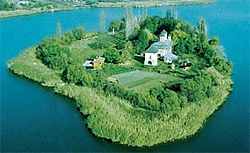 In 1458 - more than one hundred years after the church was built
(1364) - Romanian prince Vlad Tepes
(Vlad the Impaler) added thick defending walls and a dungeon.
A plaque on the floor inside the church
marks the grave with the presumed remains of the
world-known count.
In 1458 - more than one hundred years after the church was built
(1364) - Romanian prince Vlad Tepes
(Vlad the Impaler) added thick defending walls and a dungeon.
A plaque on the floor inside the church
marks the grave with the presumed remains of the
world-known count.
The monastery is located on an island on lake Snagov, and can be accessed on a pedestrian bridge or by boat.
Day Trips
Bucharest is a great starting point from which to explore the rest of the country. Away from the buzz of the city, you will find a different side of Romania - life in the countryside moves more slowly, the air is crisp and hospitality abounds.
Here are some Bucharest day-trips ideas:
Peles Castle & Sinaia Monastery
Where: Town of Sinaia, 87 miles north of Bucharest
Access: car, bus, train
Peles Castle Info
Bran (Dracula's) Castle
& Bran Ethnographic Museum
Where: Village of Bran, 120 miles north of Bucharest
Access: car, train or bus to Predeal or to Brasov
Taxi from Predeal to Bran
Bus or taxi from Brasov to Bran
Old, medieval, Town Brasov
Where: 115 miles north of BucharestAccess: car, train or bus
Brasov Info
Zimbraria Neagra (European Bison Reserve) -- Targoviste -- Palatul Brancovenesc Potlogi
Where: northwest of Bucharest
Bucharest - Neagra Bison Reserve: 48 miles,
Stop/ visit: European Bison Reserve
in village Bucsani
Neagra Bison Reserve -- Targoviste: 19 miles
Stop/ visits: the 14th century Princely Court(Curtea Domneasca) and Vhindiei Watchtower (Turnul Chindiei).
Targoviste -- Potlogi: 32 miles
Stop/ visit:
Palatul Brancovenesc,
residence of Prince Constantin Brâncoveanu, voivode of Wallachia (1688 -- 1714).
Potlogi - Bucharest: 36 miles.
Access: car
Itinerary map
Total distance: 135 miles
Targoviste - Curtea de Arges - Poenari Fortress
Where: northwest of Bucharest
Distance: Bucharest - Targoviste: 51 miles,
Targoviste - Gaesti - Curtea de Arges - Poenari: 89 miles
Poenari - Bucharest: 112 miles.
Access: car
In Targoviste, tour the 14th century Princely Court(Curtea Domneasca)
and Chindiei Watchtower (Turnul Chindiei).
The grounds are open Tuesday through Sunday from 9 a.m. to 5 p.m.
From Targoviste, continue to Curtea de Arges.
Once you reach Curtea de Arges, visit the 14th-century Princely Court and the 800 years old Princely Church.
Curtea de Arges was founded in the late 1200s by Prince Radu Negru (or Negru Voda).
Between years 1369 and 1431 Curtea de Arges was the capital of Wallachia, the southern part of Romania.
A stunning architectural gem of the town is the 16th century, Byzantine style with Moorish arabesques,
Curtea de Arges Monastery (Manastirea Curtea de Arges).
Romania's kings and queens are buried here.
Fifteen miles north of Curtea de Arges lay the ruins of Poenari Fortress,
the authentic stronghold of voivode Vlad Tepes (Vlad the Impaler) or Vlad Dracul.
Only the walls and towers still stand from the original fortress located near Poienari village,
just off the Transfagarasan highway over the Fagaras Mountains (Transylvanian Alps).
Access to fortress, perched on a cliff - high above the surrounding area, requires climbing of a 1,462-step stairway.
Horezu Monastery & Horezu Pottery Centre
Where: 120 miles northwest of BucharestAccess: car, bus
Fifty miles west of Curtea de Arges stands Horezu Monastery, the largest monastic settlement in Walachia, founded in 1690 by Prince Constantine Brancoveanu. A masterpiece of the Brancovenesti style and a UNESCO World Heritage site, Horezu is renowned for the richness of its sculptural detail, the treatment of its religious compositions and its painted decorative works. The monastery houses precious collections of frescoes and icons dating from the end of the 17th century and the beginning of the 18th century.
The nearby village of Horezu is home to one of the biggest pottery centres in Romania. Nearly a century ago, local nuns taught the villagers how to make and paint pottery, and ever since, people have come from far and wide to get their hands on Horezu's ceramic.
Targu Jiu
Where: 190 miles west of BucharestAccess: car, bus, train
Targu Jiu Info
A must for all art lovers is a visit to Targu Jiu on the banks of the River Jiu. This former market town is closely associated with Constantin Brancusi, considered by many to be the father of modern sculpture. While most of his works are on display in prestigious museums throughout the world, his trilogy of public sculptures, The Table of Silence (Masa Tacerii), The Gate of the Kiss (Poarta Sarutului) and The Endless Column (Coloana Infinitului) can be admired at the Constantin Brancusi sculptural complex in downtown Targu Jiu.
Nearby in Hobita, the birthplace of Constantin Brancusi, you can visit the house in which the sculptor spent his childhood; now home to a small museum dedicated to the universally acclaimed sculptor. The house preserves the original architecture, furniture and household items. The village is also home to the national sculpture camp "Brancusiana".
Performing Arts
Bucharest has numeros drama theatre and concert venues.
Tickets can be purchased on-line or directly at the venue's box office.
Opera & Ballet
National Opera & Ballet (Opera Nationala Romana)
Address: Blvd. Mihail Kogalniceanu 70 - 72
Tel: 021 313.18.57
www.OperaNB.ro
Box office hours: Mon. - Sun. 10 a.m. - 1 p.m.; 2 p.m. - 7 p.m.
The city's artistic life stood up to its Parisian nickname in the 1930s and today, is as vibrant as ever. The Opera House, completed in 1953, is worth visiting, not only for its brilliant performances but also for the lavish interior design. The world-renowned Romanian Opera performs in Romanian as well as Italian and German. You will be able to enjoy the classic repertoire - Puccini, Verdi, Rossini, Mozart -, innovative staging, lavish costumes, seasoned performers and choreographers. The Romanian National Ballet also performs in this theatre. Performances are held Wednesday through Sunday evenings, except during July and August.
National Operetta Theatre (Teatrul National de Opereta 'Ioan Dacian')
Address: Blvd. Nicoale Balcescu 2
Tel: 021 313.63.48
www.Opereta.ro
Box office hours:
Tue. - Sat. 11 a.m. - 6 p.m.; Sun. 2 p.m. - 6 p.m.;
Closed Mon.
Comic plots, extravagant staging, lavish costumes, high caliber singers and orchestra are all part of the charm of the light, frothy performances at the Ion Dacian Operetta.
Symphonic Music
George Enescu Philharmonic at Romanian Athenaeum (Filarmonica George Enescu)
Address: Str. Benjamin Franklin 1
Tel: 021 315.00.26 or 315.25.67
www.FGE.org.ro
Box office hours: Tue. - Fri. 12 p.m. - 7 p.m.;
Sat. & Sun. 4 p.m. - 7 p.m.;
Closed Mon.
The Romanian Athenaeum is the main venue of the biennial classical music festival "George Enescu"
Festivalul de Muzica Clasica "George Enescu"
Famous artists and conductors have performed here throughout the years.
Among them: Erich Kleiber, Sergiu Celibidache, Ionel Perlea, Herbert von Karajan, Dinu Lipatti, Arthur Rubinstein, Pablo Casals and Yehudi Menuhin.
National Radio Orchestra and National Chamber Orchestra
Address: Str. General Berthelot 60-64 (Sala Radio)
Tel: 021 303.12.11 or 303.14.28
www.OrchestreRadio.ro
The National Radio Orchestra, one of the best in the country, presents frequent classical chamber music performances at the music hall in the radio building.
Theatre
Theatre performances are very popular in Romania and for most shows tickets sell-out within hours.
While most theatre productions are performed in Romanian, sometimes,
it is possible to find performances in German or English at various small theatres.
There are 16 major theatres in Bucharest offering performances for all ages.
The theatre season closes during the summer, from July to September, although some small student and underground theatres do remain open.
National Theatre (Teatrul National)
Address: Blvd Nicolae Balcescu 2
Tel: 021 314.71.71
www.TNB.ro
Three auditoriums host professional domestic and foreign plays by a broad selection of both classical and contemporary Romanian playwrights.
The theatre's Great Hall (Sala Mare), hosts the grand productions,
while the Amphitheatre (Sala Amfiteatru) shows smaller productions and TV shows,
and the Studio Hall (Sala Atelier) gets a mix of lower-key shows and presentations.
National Jewish Theatre (Teatrul Evreiesc de Stat)
Address: Str. Dr. Iuliu Barasch 15
www.Teatrul-Evreiesc.com.ro
Tel: 021 323.39.70
The Jewish Theatre offers performances in Yiddish, Hebrew and Romanian (translation into Yiddish and Hebrew available).
Entertainment
Live Music
Art Jazz Club
Address: Blvd. Nicolae Balcescu 23A
Tel: 0722 589.058
Open: Tue. - Sun. 1 pm - 3 am
Green Hours 22 Jazz Café
Address: Calea Victoriei 120
Tel: 021 314.57.51
www.GreenHours.ro
Open: 9 am -- 4 am (next day)
Laptaria lui Enache/ La Motor
Address: Blvd. Nicolae Balcescu 2
Tel: 021 315.85.08
Located nearby the National Theatre, this bar is filled with university students, artists, musicians and young professionals.
Usually crowded, the bar (called Laptaria lui Enache) is open all year long, while its rooftop counterpart (called La Motor)
is open only during the summer when movies are shown on the terrace.
At Laptaria, you can catch live music most evenings.
Cinemas
Foreign movies are generally shown in the original language with Romanian subtitles. Current film listings are available online www.sapteseri.ro
Circus
Bucharest Globus Circus (Circul Globus Bucuresti)
Address: Aleea Circului 1
Tel: 021 210.24.19 or 210.49.98
www.CirculMetropolitan.ro
Built in 1960, the enormous, permanent big-top circus is the centerpiece of a small park.
With seating for more than 3,500 spectators, Bucharest's circus continues to host excellent performances, put on by both local and touring companies.
Casinos
In recent years, several casinos have opened up in Bucharest, one of the few cities in east-central Europe offering gambling opportunities.
Many 18th and 19th century palaces and mansions now house elegant beaux-arts casinos, where guests can play blackjack, poker, craps, roulette, baccarat and other games of chance, dine on sumptuous buffets and dance all night to live music.
Bucharest Casino (Inter-Continental Hotel)
Address: Blvd. Nicolae Balcescu 4
Tel: 021 310.20.20
www.casinobucharest.ro
Grand Casino (J.W. Marriott Grand Hotel)
Address: Calea 13 Septembrie 90
Tel: 021 403.08.01
www.Grand-Casino.ro
Havana Princess Casino
Address: Blvd. Elisabeta 13
Tel: 021 313.98.23
Open: 24 hours
Lido Casino
Address: Str. C.A. Rosetti 13
Tel: 021 311 0101
Open: 24 hours
Mirage Casino
Address: Blvd. Magheru 8-10
Tel: 021 313.89.52
Open: 24 hours
Palace Casino
Address: Calea Victoriei 133
Tel: 021 311.97.44
www.casinopalace.ro
Open: 24 hours
Partouche Casino (Hotel Athenee-Palace Hilton)
Address: Str. Episcopiei 1-3
Tel: 021 314.72.00
Open: 24 hours
Plaza Casino Club
Address: Calea Victoriei 163
Tel: 021 310.24.80
Open: Mon. - Sun. 2:00pm - 7:00am
Queen Casino
Address: Calea Dorobantilor 5-7
Tel: 021 599.11.26
www.queen-casino.ro
Open: 24 hours
CITY ESSENTIALS
Transportation
Public Transportation
Bucharest's public transportation network includes:
bus (autobuz), tram (tramvai), trolley bus (troilebuz) and subway (Metrou).
This 'combo ticket' is valid for unlimited rides, for 24 or 72-hours, for:
~ the train from Bucharest International Airport to Gara de Nord Terminal
~ bus 783 from Bucharest International Airport to Downtown
~ all urban, above-ground, transport: bus, tram and trolleybus
~ Bucharest Metro (subway)
Cost: 20 lei / 24-hours card and 40 lei / 72-hours card.
Buses, trams and trolley buses operate - between 5 am and 11:59pm.
The subway operates - from 5 am until 11 pm.
Tickets/cards must be purchased beforehand and validated upon boarding.
Travelers may be asked to show the validated ticket/card during the trip.
Travelers without a validated ticket must pay a 500 Lei ($120.00) penalty (Suprataxa).
Tickets or passes can be purchased at any kiosk displaying the STB logo.
STB maps can be found at kiosks near bus and tram stops or you can print one here.
Bucharest Public Transport Route Planner.
Bucharest above-ground local transportation
(bus / tram / trolley bus) fares and passes:
- magnetic travel card (electronic wallet): 4 Lei (approx. $0.95)
- one-trip ticket (90 minutes): 3 Lei (approx. $0.75)
- 10-trips (90 minutes each trip): 25 Lei (approx. $6.25)
- day-pass: 8 Lei (approx. $1.95)
- three-day pass: 20 Lei (approx. $5.25)
- seven-day pass: 30 Lei (approx. $7.50)
- above-ground month pass: 80 Lei (approx. $19.50)
- one trip with any public transport means (above-ground and subway): 5 Lei (approx. $1.20)
(one subway ride and 90-minutes trip with any above-ground transport means) - all public transport month pass: 140 Lei (approx. $33.50)
(unlimited above-ground transportation and subway rides)
Tickets are interchangeable for the bus, tram and trolley bus, with the exception of express buses.
Express Bus 783
connects Bucharest International Airport with downtown Bucharest
(bus 783 operates 24 hours a day).
Two or 10-journey tickets, as well as monthly passes, are available for all express buses.
There is direct train service from the city's main train terminal (Gara de Nord) to Bucharest international airport.
Above-ground & Subway 'combo' fares:
- one-trip (bus/ tramway and metro - unlimited validations within 60 minutes): 5 Lei (approx. $1.25)
- 10-trips (bus/ tramway and metro - unlimited validations within 60 minutes): 34 Lei (approx. $8.50)
- Day Pass unlimited: 17 Lei (approx. $4.25) - unlimited rides for one day
Bucharest Subway (Metrou) connects the outskirts of the city
with the downtown and the main train terminal (Gara de Nord);
subway operates - from 5 am to 11 pm.
There are five subway (Metrou) lines (M1, M2, M3, M4 and M5). Subway stations are indicated with the letter "M" (blue, on a white board).
Metro maps can be printed here or can be purchased in bookshops and newspaper kiosks.
The final destination is indicated on the front of the train. Each stop is announced as the train nears the station.
Trains arrive every four to seven minutes during peak times and every 15-20 minutes off-peak times.
The average distance between subway stops is about one mile.
Subway fares:
- one-trip metro card: 3 Lei (approx. $0.75)
- two-trips metro card: 6 Lei (approx. $1.45)
- 10-trip metro card: 25 Lei (approx. $6.00)
- Day Pass unlimited: 8 Lei (approx. $2.00) - unlimited rides for one day
- 3-day pass unlimited: 20 Lei (approx. $5.00)
- 7-day pass unlimited: 30 Lei (approx. $7.50) - unlimited rides for seven days
- month-pass unlimited: 80 Lei (approx. $20) - unlimited rides / calendar month
Airport Transportation
Henri Coanda International Airport (OTP)
Address: Calea Bucurestilor 224
Tel: 021 204.12.00 or 021 204.12.10
www.BucharestAirports.ro
Most international flights arrive at Henri Coanda (Otopeni) Airport.
Airport facilities include ATM, currency exchange office, Taxi Desk and cell phone rentals.
Major car rental companies have offices located on the arrivals/ baggage claim level.
There are non-stop flights to Bucharest from most major European cities and in the Middle-East and connecting flights from the United States, Canada, Australia and New Zealand.
...
Domestic Flights:
Scheduled domestic flights from/to Cluj-Napoca (CLJ), Iasi (IAS), Oradea (OMR),
Satu Mare (SUJ),
Sibiu (SBZ), Suceava (SCV), Timisoara (TSR) also depart from/ arrive to Henri Coanda Airport.
Airlines offering flights from Bucharest to major cities in Romania include:
Tarom (flights to all destinations above)
Blue Air (flights to/ from Cluj, Iasi, Oradea and Timisoara)
Ryan Air (flights to/ from Timisoara)
Wizz Air (flights from Bucharest to Cluj)
Transportation between Henri Coanda International Airport and city centre:
Distance from Bucharest airport to downtown: 18 km (11 miles).
Several Taxi companies operate in Bucharest, and their rates can vary.
Taxis can be called by using the touch screen computer (Dispecerat Automatizat Taxi)
available next to the Taxi Desk (Taxi la Comanda) located in the arrivals terminal.
There is no flat rate taxi transportation available from Bucharest Airport to downtown.
Rate / km: 1.99 lei to 3.50 lei ($0.50 -- $0.90).
There is no extra-charge for luggage.
The average fare from the airport to downton Bucharest is less than 70 Lei (the equivalent of $18.00).
Do not accept rides from drivers who might approach you inside or in front of the terminal,
you will risk to be overcharged.
If you run into a problem with any taxi in
Bucharest – or if you are suspecting that you have
met a dishonest driver - ask for a receipt and if possible try to write down the vehicle's license plate #.
To file a Bucharest Taxi complaint please call
021 201 3242 (Transportation Bureau of the Police Department) and/or
021 9844 (Bucharest City Hall - Complaints)
021 9551 (Consumer Protection Authority).
Shuttle service from / to Bucharest airport:
www.shuttledirect.com/en/airport/OTP
www.bucharestairportshuttle.com/airport_shuttle.php
Express Bus 783 takes travelers from the airport to the city centre,
with stops at Baneasa Airport, Piata Presei Libere, Piata Victoriei, Piata Romana, Piata Universitatii and Piata Unirii.
Bus 783 leaves from the Arrivals terminal every 15 to 20 minutes
(every 40 minutes between 10 p.m. and 6 a.m.).
The journey to Bucharest downtown takes approximately 40 minutes.
Note: Before boarding the bus, please purchase a public transportation card
("Activ Card")
available from at the 'STB' ticket booth in the arrivals terminal or next to the bus stop.
The bus ticket booth is open daily from 6 a.m. to 8:30 p.m.).
One 'Activ Card' costs 3.70 Lei (about $0.85).
To ride the bus you will also need to add value to your card
(add 7 Lei for two trips from / to the airport or 3.50 Lei for one trip).
Your Activ card must be validated as you board the bus.
Transportation between Henri Coanda International Airport and Bucharest main train terminal (Gara de Nord):
By Train
Henri Coanda Express Train to the main train terminal (Gara de Nord)
The journey from the airport to the train station takes about 22 minutes.
One-way ticket costs 5 Lei ($1.25) for Adults
3 Lei ($0.75) for Childrens (up to 10 y.o.).
Tickets can be purchased at the CFR kiosk International Arrivals Terminal.
Train Schedules and Reservations
Baneasa Airport
Address: Sos. Bucuresti-Ploiesti 40
Tel: 021 232.00.20 or 9713
baneasa-airport.ro
Baneasa Airport, located six miles from downtown Bucharest, is mostly used for private planes.
Public transportation between Baneasa airport and city centre:
Bus #131 and #783 to downtown Bucharest
Bus #205 to the main train terminal (Gara de Nord)
Taxi - $12.00 (average)
...
Train Transportation
Bucuresti North - main train terminal (Gara de Nord)
Address: Blvd. Garii de Nord 2
Tel: 9521
Bucharest's main train terminal, Gara de Nord, is located three miles northwest of Bucharest downtown.
International trains
There are daily trains from/to Athens, Belgrade, Budapest, Istanbul, Prague, Sofia, and Vienna. Trains from/to Western European cities run via Budapest.
Getting to Romania / By Train
To check international trains schedule to/ from Bucharest please visit:
RomaniaTourism international transportation section
To check schedules and fares for domestic trains please check our Romania Transportation section.
Note: For Bucharest please select Bucuresti Nord.
SNCFR Ticket Offices:
Agentia de Voiaj SNCFR - Griviţa
Address: Calea Griviţei, 139
Telephone: 021 313.26.42
Open:
Mon. - Fri.: 8 am – 6 pm;
Closed: Sat. and Sun.
Agentia de Voiaj SNCFR - Unirii
Address: Piata Naţiunilor Unite – Postal Office
Telephone: 0752 504.262
Open:
Mon. - Fri.: 8:30am - 6:30pm;
Closed: Sat. and Sun.
Agentia de Voiaj SNCFR – Bucharest Airport
Address: Bucharest Airport – Arrivals Terminal
Telephone: 021 201.33.04
Open: non-stop
The SNCFR ticket offices offer train schedules information and ce tickets for future travel.
Tickets for same-day travel can only be purchased at the train station.
...
Bus Transportation
International Bus Companies serving Bucharest:
Atlassib
Tel: 021 222.47.35
www.atlassib.ro
Destinations: Austria, France, Germany, Italy, Spain, Sweden
Departures from: Soseaua Alexandriei 164
Autotrans Calatori Filaret
Tel: 021 335.95.83
www.acfilaret.ro
Destinations: Bulgaria
Departures from: Piata Garii Filaret 1
COMATI PSG
Tel: 0723 450.475
www.comati-psg.ro
Destinations: Denmark, Sweden
Departures from: Str. Buzesti 44
DoubleT
Tel: 021 313.36.42
www.doublet.ro
Destinations: Austria, France, Germany, Greece, Italy, Spain, Sweden, Switzerland
Departures from: Calea Victoriei 2
Eurolines Touring
Tel: 021 210.08.90
www.eurolines.com
Destinations: Austria, Belgium, Czech Republic, France, Germany, Greece, Italy, Luxemburg Netherlands, Portugal, Spain, Switzerland
Departures from: Str. Buzesti 44
Nordic Tours
Tel: 021 305.60.06
www.nordic.ro
Destinations: Denmark, Norway, Sweden
Departures from: Piata Garii Filaret 1
Orlan
Tel: 0269 224.101
www.orlan.cz
Destinations: Czech Republic, Slovakia
Departures from: Gara de Nord (North train terminal)
Perla Trans
Tel: 021 336.00.13
www.perlatrans.com
Destinations: Greece, Turkey
Departures from: Soseaua Viilor 54
Torpedo Tur International
Tel: 021 232.02.87
www.transportchisinau.cabanova.ro
Destinations: Republic of Moldova
Departures from: Gara de Nord (North train terminal)
...
Taxi companies
Several taxi companies operate in the city.
Taxis can be summoned by telephone or hailed on the street.
Fares per km are posted on driver's and passenger's doors.
Average Taxi fares:
Initial Fee: 1.99 Lei ($0.50)
plus 2.0 Lei / km ($1.12 / mile)
Please note that some taxi companies may post and/or charge up to five times the fares indicated above.
Check the taxi fares and ask the driver to confirm the approximate cost of the ride, if not sure.
Bucharest Taxi Companies include:
Alfa - 9488
As - 9435
Cristaxi - 9461
Cobalcescu - 9451
Fly - 9440
Leone - 9425
Meridian - 9444
Mondial- 9423
Perozzi - 9631
Prof Taxi - 9422
Speed - 9477
Taxi 2000 - 9494
Do not accept rides from drivers who might approach you at the airport, train station
or in the street;
you will risk to be overcharged.
If you run into a problem with any
taxi in Bucharest – or if you are suspecting that you have met a dishonest driver - ask for
a receipt and if possible try to write down the vehicle's license plate #.
To file a complaint you can call 021 9551 (Consumer Protection Authority)
and/or 021 201 3242 (Transportation Bureau of the Police Department).
...
Car Rental
All major international and local car rental companies are represented
in Romania's capital city.
Contact us if you need a list of all car rental companies in Bucharest.
...
Bicycle Rental
Bucharest bicycle rental centers
Teo Bikes
E-mail
www.Teo-Bikes.ro
La Bicla Loca
E-mail
www.LaBiclaLoca.ro
Zebra Bike
Contact
www.Zebra-Bike.ro
Bate Saua
E-mail
www.BateSaua.ro
I Velo
E-mail
www.IVelo.ro
...
Shopping
Since the 1990s, brand names and high-end stores have been pushing their way into the Romanian market. From high fashion boutiques to art galleries, shopping in Bucharest can fit any taste or budget. Stroll down Blvd. Magheru from Piata Romana to Piata Universitatii for a shopping extravaganza or hit one of the many shopping malls favored by the local rich & famous.
Handicrafts (Artizanat)
Folk crafts, such as embroidered clothing and linen, painted or beaded eggs, carpets, pottery, woodcarvings and icons, make interesting gifts and souvenirs. Romanian peasants do magnificent embroidery on cotton, wool and leather. Look for blouses, skirts, exotic coats, rugs, tablecloths and lacework. Icons, new and old, painted on glass or wood are outstanding. A good selection can be found at the Romanian Peasant Museum,
the Village Museum,
most department stores.
Shopping Centers
Afi Palace Cotroceni Mall
Address: Blvd. Timisoara
Tel: 031 425.75.10
www.aficotroceni.ro
Open: Mon. – Sun. 10 a.m. – 10 p.m.
Baneasa Shopping City
Address: Sos. Bucuresti – Ploiesti 42
Tel: 021 306.06.58
www.baneasashoppingcity.ro
Open: Mon. – Sun. 10 a.m. – 10 p.m.
Bucuresti Mall
Address: Calea Vitan 55-59, Bucharest
Tel: 021 327.67.00
www.bucurestimall.com.ro
Open: Mon. - Sun. 10 am - 10 pm
Grand Arena Mall
Address: Blvd. Metalurgiei 12-18, sector 4
Tel: 031 425.75.14
www.grandarena.ro/orar.php
Open: Mon. – Sun. 10 a.m. – 10 p.m.
Liberty Center
Address: Str. Progresului 151 - 171
Tel: 021 369.98.75
www.libertycenter.ro
Open: Mon. – Sun. 10 a.m. – 10 p.m.
Mario Plaza
Address: Calea Dorobantilor 172, Bucharest
Tel: 021 230.47.71
Open: Mon. - Sat. 10 am - 9 pm, Sun. 10 am - 2 pm
Plaza Romania Mall
Address: Blvd. Timisoara 26, Bucharest
Tel: 021 407.84.16
www.plazaromania.ro/index.php
Open: Mon. - Sun. 10 am - 10 pm
Unirea Shopping Center
Address: Piata Unirii 1, Bucharest
Tel: 021 303.03.07
www.unireashop.ro
Open: Mon. - Sat. 9 am - 10 pm; Sun. 9 pm - 8 pm
World Trade Plaza
Address: Blvd. Expozitiei 2, Bucharest
Tel: 021 202.44.50
www.wtcb.ro/shopping_gallery.html
Open: Mon. - Sun. 8am - 8pm
Art Galleries
Galeria 23
Address: Str. Lipscani 63 - 65, Bucharest
Tel: 740.819.826
Web: www.hantei23.com
Open: Mon. - Fri. 10 am - 6 pm; Sat. 10 am - 2 pm; Closed Sun.
Galeria Galateca
Address: Str. C. A. Rosetti 2-4, Bucharest
Open: Mon. - Sun. 11 am - 7 pm
Galeria Galateea
Address: Calea Victoriei 132, Bucharest
Tel: 021 659.38.14
Open: Mon. - Sat. 11 am - 7 pm; Closed Sun.
Galeria Hanul Cu Tei
Address: Str. Blanari 5-7, Bucharest
Tel: 021 313.01.81
Open: Mon. - Sat. 11 am - 7 pm; Closed Sun.
Galeria Nemtoi
Address: Calea Victoriei 126, Bucharest
Tel: 021 312.98.00
Open: Mon. - Fri. 10 am - 8 pm, Sat. 10 am - 6 pm; Closed Sun.
Galeria Noua
Address: Str. Academiei 15, Bucharest
Tel: 021 322.81.59
Open: Wed. - Sun. 11 am - 7 pm; Closed Mon. & Tue.
Galeria Orizont
Address: Blvd. Nicolae Balcescu 23A, Bucharest
Tel: 021 315.89.22
Open: Mon. - Fri. 10 am - 7 pm; Sat. 10 am - 2 pm; Closed Sun.
Galeria Simeza
Address: Blvd. Magheru 20, Bucharest
Tel: 021 659.38.25
Open: Mon. - Fri. 10 am - 6 pm; Sat. 10 am - 2 pm; Closed Sun.
Antiques
If it is antiques that you fancy, Bucharest provides plenty of opportunities to fulfill your every whim.
Antiques can be found in art galleries along Calea Victoriei and around the Old Historical Center (Lipscani street).
Thomas Antiques
Str. Covaci 19 (zona Lipscani)
030094 Bucharest, Romania
Open: Sun-Mon. 10:00am - 10:00pm; Fri, Sat. 10:00am - 12:00am
Amadeus Antiques
Address: Str. Quinet 3, Bucharest
Tel: 021 315.10.83
Open: Mon. - Fri. 10:00am - 6:00pm; Closed Sat. & Sun.
Craii de Curtea Veche
Address: Str. Covaci 14, Bucharest
Tel: 021 314.83.04
Open: Mon. - Fri. 10:00am - 6:00pm; Sat. 10:00am - 3:00pm; Closed Sun.
Da Vinci
Address: Calea Victoriei 118, Bucharest
Tel: 021 210.40.94
Open: Mon. - Fri. 9:00am - 6:00pm; Sat. 9:00am - 3:00pm; Closed Sun.
Galeria de Arta Dorobanti
Address: Str. Tudor Stefan 13, Bucharest
Tel: 021 231.49.53
Open: Mon. - Fri. 10:30am - 6:30pm; Sat. 11:00am - 3:30pm; Closed Sun.
Hanul cu Tei
Address: Str. Lipscani 63, Bucharest
Tel: 021 315.56.63
Open: Mon. - Fri. 10:00m - 6:00pm; Sat. 10:00am - 3:30pm; Closed Sun.
Quasar Antiques
Address: Calea Victoriei 63-81, Bucharest
Tel: 021 313.47.26
www.quasarantiques.net
Open: Mon. - Fri. 10:30am - 7:30pm; Sat. 10:30am - 2:30pm; Closed Sun.
Book stores (Librarie)
Libraria Carturesti
Location 1: Str. Edgar Quinet 9, Bucharest
Tel: 021 311.06.46
Location 2: Str. Pictor Verona 13, Bucharest
Tel: 021 212.19.22
www.carturesti.ro
Open: Mon. - Sun. 9 am - 10 pm
Books, tea, music . (some books in English)
Music (Muzica)
Visitors interested in Romanian music can find recordings of pop artists and bands, such as Loredana Groza and Morandi, pan flute artist Gheorghe Zamfir and popular folk singers such as Maria Tanase.
Magazinul Muzica
Address: Calea Victoriei 41- 43, Bucharest
Tel: 021 313.96.74
Open: Mon. - Fri. 9:30am - 7:00pm; Sat. 9:30am - 2:30pm; Closed Sun.
...
Fresh Produce Markets (Piata)
Piata Amzei
Address: Str. Christian Tell 6
(between Calea Victoriei and Blvd. Magheru, near Piata Romana)
Tel: 021 211.67.26
This is the city's most centrally located outdoor market.
The outdoor market is surrounded by butcheries, cheese, flower and medicinal plant shops.
Piata Dorobantilor
Address: Blvd. Radu Beller 3 - 5
Tel: 021 231.92.99
Upscale neighborhood market with a selection of fresh produce and flowers
Piata 1 Mai
Address: Blvd. Ion Mihalache 123
Tel: 021 317.14.63
Resembling an Oriental bazaar, this is the place to find everything from
fresh cheese and eggs, fruits and vegetables, to flowers and household items.
Piata Obor
Address: Campul Mosilor 5
Tel: 021 252.69.54
Bucharest's biggest outdoor market; here, you can find here a huge food market and a "bazaar".
...
Hotels and other Accommodations in Bucharest
If interested to stay in a historic, distinctive hotel please visit
RomaniaTourism.com/Distinctive-Hotels.html#Bucharest

Tourist Info
Bucharest Tourist Information Office
Address: Piata Universitatii underpass
(Pasajul Universitatii)
Telephone: 021 305.55.00 extension 1003
turism@bucuresti-primaria.ro
www.SeeBucharest.ro
Bucharest is safe and hospitable ; violent crime is almost non-existent.
As in any large city visitors are advised to take usual safety precautions.
Do not draw unnecessary attention to your person, money or jewelry and be aware of pickpockets and scam artists.
Never accept taxi/ car rides, tours or guide services from strangers, no matter how presentable or fluent in English, who approach you on the street.
Weather
Bucharest has a four-season climate. In the spring, the weather can quickly alternate between rain and sunshine.
June, July and August are the hottest months.
As the leaves begin to change color, you can still enjoy warm and sunny days while taking a stroll in the city's many parks or down Calea Victoriei.
Winters can be quite cold with moderate snowfall.
| Average temperatures (Fahrenheit) | |
|---|---|
| Month | Average |
| January | 22-34°F |
| February | 26-39°F |
| March | 32-50°F |
| April | 42-64°F |
| May | 50-73°F |
| June | 57-80°F |
| July | 60-83°F |
| August | 70-90°F |
| September | 52-76°F |
| October | 42-64°F |
| November | 34-50°F |
| December | 27-38°F |
Bucharest Weather Forecast
http://www.weather.com/weather/today/l/ROXX0003:1:RO
Postal Services & Telephone
Post offices display a postal horn symbol and the word Posta.
Main Post & Telephone Office
Address: Str. Matei Millo 10 (off Calea Victoriei)
Open: Mon. - Fri. 7:30am - 8 pm; Sat. 8 am - 2 pm; Closed Sun.
Telephoning Bucharest from Abroad
International Access Code +40 (country code) + 21 or 31 (area code) + telephone number (seven digit number)
Pharmacies & Hospitals
Pharmacies in Bucharest are well stocked
and pharmacists are authorized to recommend medication for most (minor) ailments.
There are several pharmacies (Farmacie) open 24 hours a day.
Emergency Clinic Hospital
(Spitalul de Urgenta Floreasca)
Address: Calea Floreasca 8
Tel: 021 317.01.71 or 317.01.21
...
Bucharest - Useful Telephone Numbers
General emergency phone numbe: 112
Bucharest Archives(Arhivele Nationale - Directia Municipiului Bucuresti)
Address: Calea Văcăreşti 470
Telephone: 021 332.07.71 and 021 305.55.50
E-mail Bucharest City Hall
(Primaria Capitalei)
Address: B-dul Regina Elisabeta 47
Telephone: 021 490.00.33 Consumer Protection Agency
(Autoritatea pentru Protectia Consumatorului)
Telephone: 021 9551
...
Festivals & Events
A compilation of Romania’s main events is available at
www.RomaniaTourism.com/Festivals-Events
Events that take place every year in Bucharest include:
- Easter Gifts - Arts & Crafts Fair (April)
- Rokolectiv festival of electronic music and arts (April)
- BRD Nastase Tiriac Tennis Trophy (April)
- 'Next' International Film Festival (June)
- Bucucuresti International Film Festival (B-EST IFF)
- International Music Festival 'Jeunesses Musicales' (May)
- Bucharest International Jazz Competition (July)
- Bucharest International Music Festival 'EuropaFest' (May)
- Bucharest of Old Festival (in Old Town Bucharest) (May)
- 'GayFest' Gay Pride Festival (June)
- Bucharest 'ArtPhoto' Image & Photography Festival (May - June)
- OstFest Music Festival - (June)
- Rock The City - Music Festival (June)
- Bucharest "D'Ale Bucurestilor" Street Music Festival (June)
- Craftsmen's Fair at the Village Museum in Bucharest (May - July)
- B'ESTFEST top international dance, indie and world music acts (July)
- Bucharest Street Theatre Festival (July)
- International Festival of Radio Ensembles "RadiRo" (September)
- International Furniture and Interior Design Fair (BIFE-TIMB) - (September)
- George Enescu Music Festival (September- biennial, every odd year)
- Early Music Festival (from medieval pieces to Renaissance, Baroque,
Byzantine and Gregorian) - (October) - Autumn Fair at Bucharest's Village Museum (October)
- Romanian National Theatre Festival (October)
- 'eXplore Dance' International Contemporary Dance Festival - (October)
- 'Kinofest' - cutting-edge short films and new media (October)
- St Nicholas Fair at Bucharest's Museum of The Romanian Peasant (December)
- Winter Gifts Arts & Crafts Fair - Museum of the Romanian Peasant (Dec)
- Eduard Pamfil International Festival of Young Guitar Players (December)
...
Maps
- City Map (Harta orasului Bucuresti)
- Bucharest Area Map (Regional Map)
- Bucharest Subway Map (Harta Metroului Bucuresti)
- Bucharest Public Transportation map








